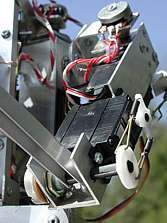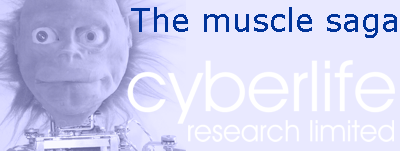|





| |
 Lucy MkI used simple servomotors rigged up to behave roughly like pairs of
muscles. However, these had many problems: Lucy MkI used simple servomotors rigged up to behave roughly like pairs of
muscles. However, these had many problems:
- They were too weak to lift a useful payload
- They were very noisy (making it difficult for Lucy to learn to hear and
speak)
- They reacted too slowly, making them stiff when they were supposed to be
relaxed, and twitchy under tension.
For Lucy MkII we needed far more powerful and responsive muscles, with more
biologically realistic qualities.
This latter point is important. The vast majority of robots use 'stiff' motor
systems - their limbs are directly connected to the gearboxes of the motors.
This is very unlike the muscles of animals in several ways:
-
Animals can let their limbs go loose and floppy. This allows them to
swing in a natural rhythm, and in humans allows a mother, say, to guide her
child's arms and demonstrate everything from how to draw a triangle to the
right way to swing a nine iron.
-
Animals can feel resistance and external pressure on their limbs by
measuring the stretch in their muscles. This is an important source of
information for building a model of the animal's position in space. Many robots will just jam solid if
an arm catches on an obstruction - the robot simply doesn't know it is
there.
-
Most robots move in very 'mechanical' ways, quite unlike the fluid
ballistic movements of animals. If we are to understand how the brain
controls movement it is very important that Lucy's body emulates a
biological body as much as possible. Almost certainly the way the brain
controls movement relies strongly on the particular qualities of muscles and
tendons. Moving such complex and non-linear mechanisms is very much harder
in the first instance, but far more likely to provide useful insights than
trying to bypass the problem by building high-precision, highly predictable
motor systems.
Unfortunately, there are no current technologies that can match animal muscle for
length of stroke, speed, elasticity, strength and efficiency. There are many
materials under development - memory alloys, hydrogels, pneumatics, etc. - that
may fit the bill one day, but for the moment ordinary DC motors are about the
only easily accessible source of motive power. The problem is how to make motors
emulate muscles.
My first solution was to use an elastic actuator, similar in concept to those
used in MIT's
Cog robot. This had both practical and theoretical
problems.
The second solution was really neat - much
simpler, cheaper and more biological in its qualities. However, so far I've been
unable to reduce the vibration to a satisfactory level, given the engineering
facilities available and the space constraints in the robot.
Sadly I couldn't perfect this method and eventually ran out of time and
money, so finally I've plumped for a third solution
which is nowhere near as nice but has the considerable advantage of actually
working!
|
